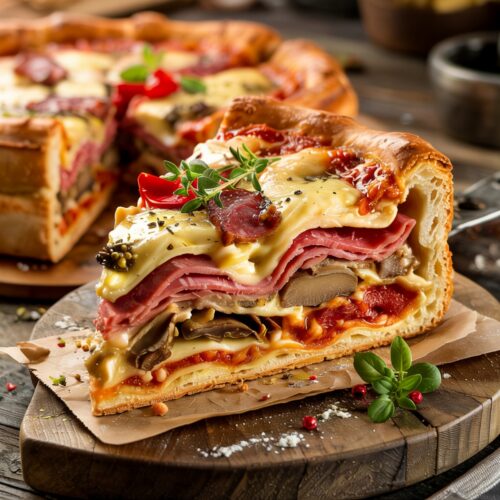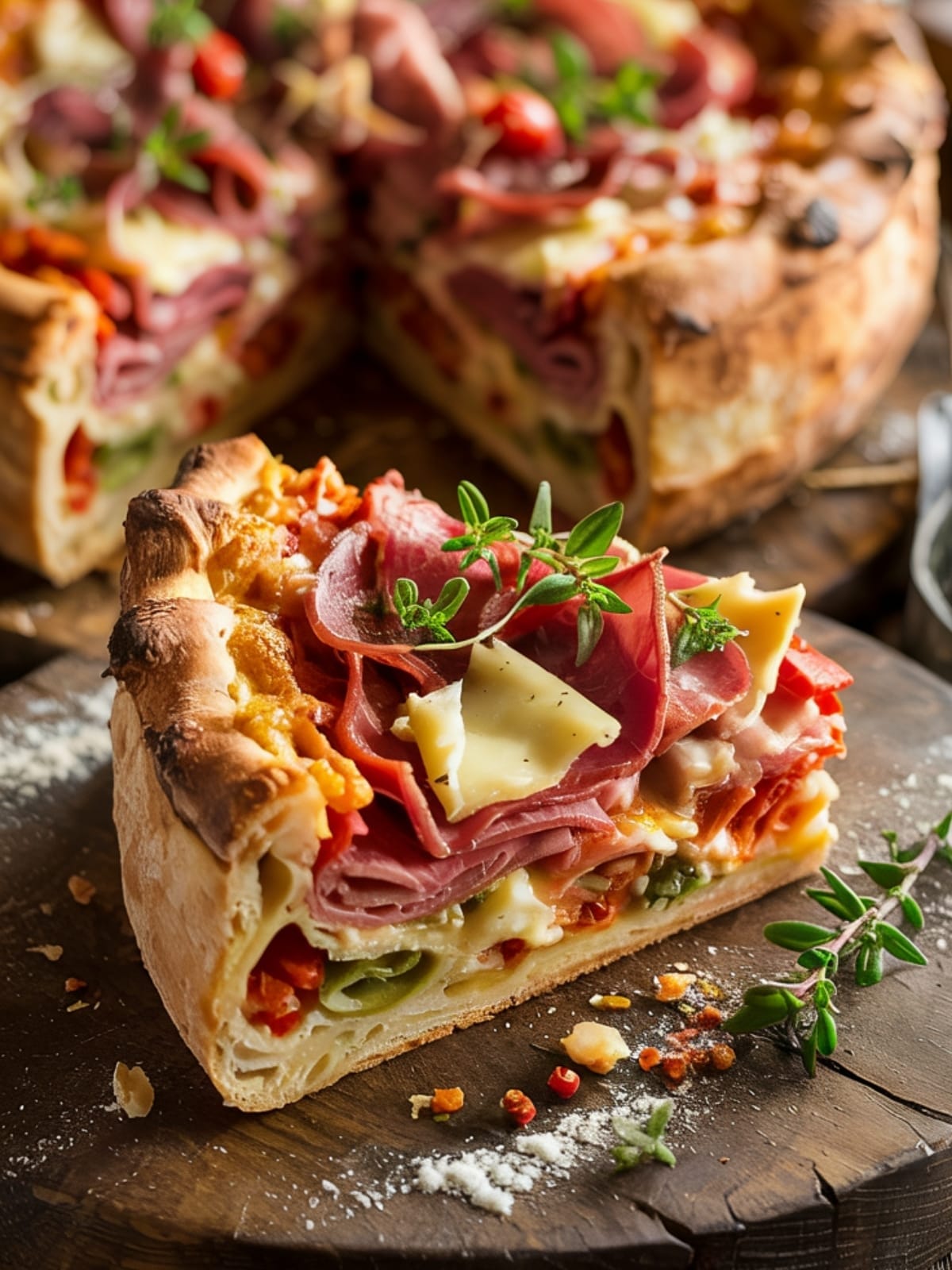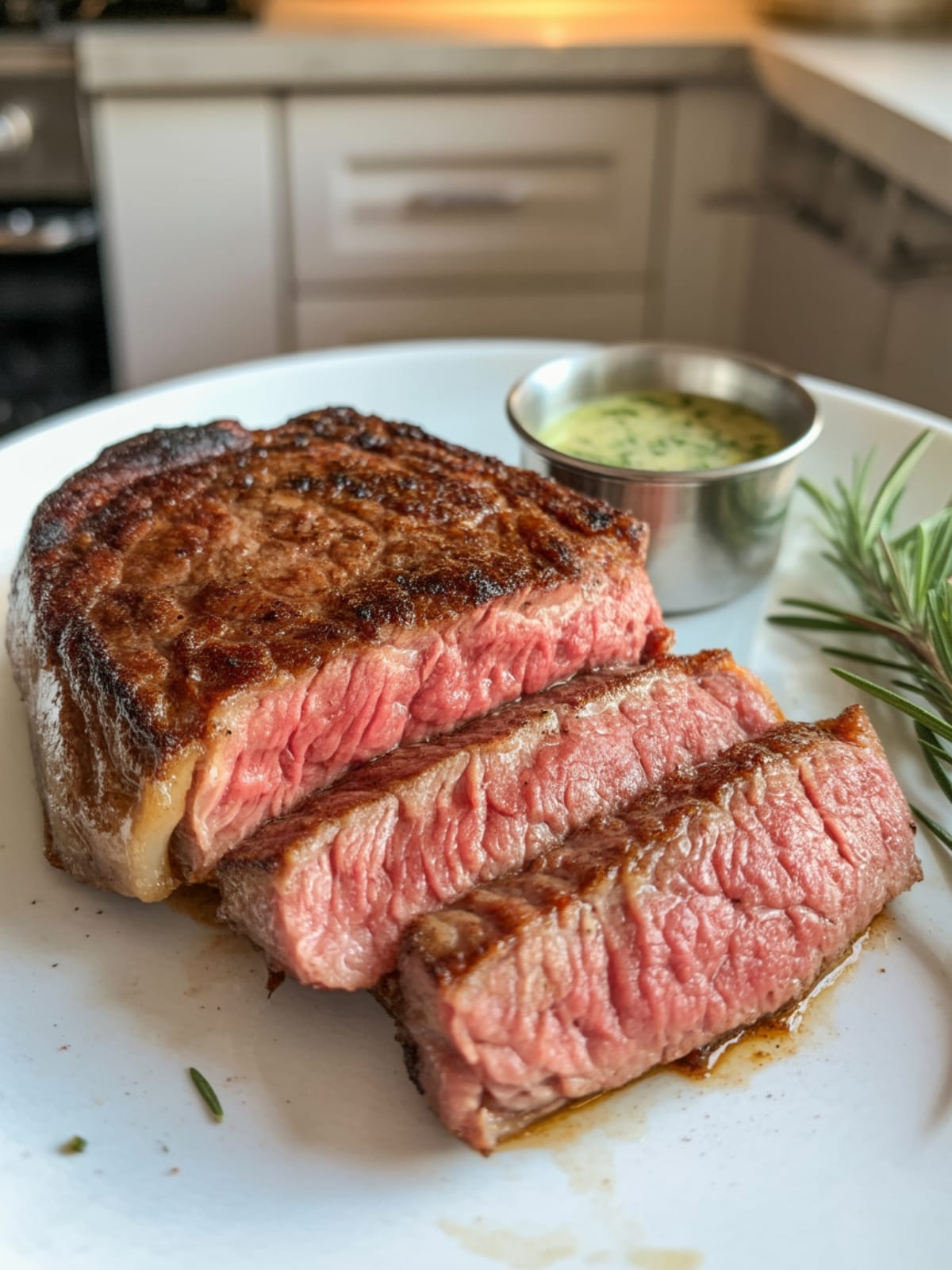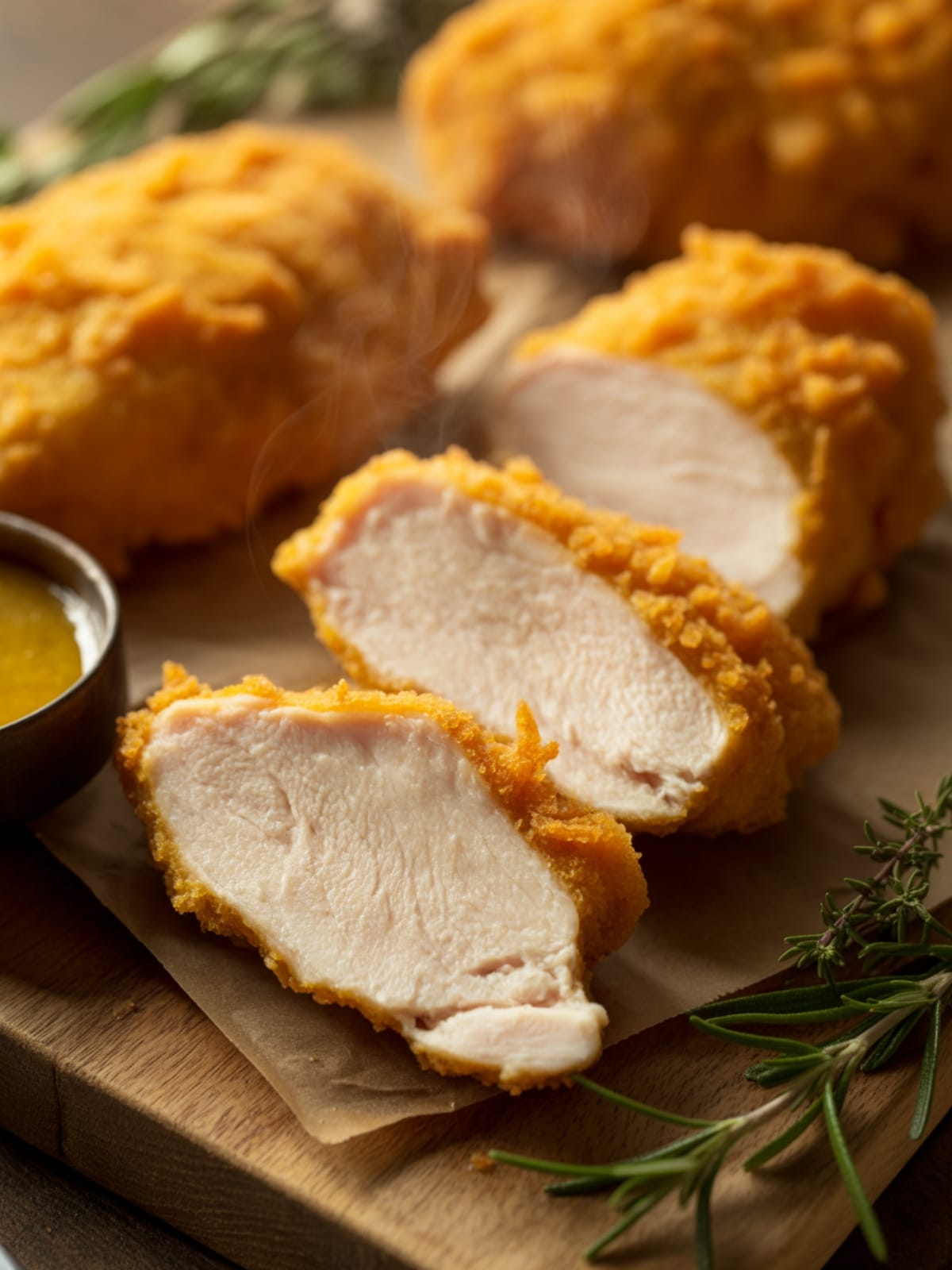Ever wanted to create something that makes people gasp when you bring it to the table? Something that screams “I could totally open my own Italian deli if this whole regular life thing doesn’t work out”? Pizza Rustica is your ticket to that fantasy. Despite its name, this isn’t pizza in the way you’re thinking. It’s basically what would happen if a quiche and a charcuterie board had a beautiful baby inside a pastry crust. And it’s glorious.
Why This Recipe is Awesome

Let me tell you why Pizza Rustica (also known as Italian Easter Pie) deserves a spot in your recipe collection: it’s a showstopper that’s actually easier to make than it looks. The combination of savory meats, cheeses, and that buttery crust creates something that tastes like it came straight from an Italian grandmother’s kitchen.
This is not your average pie. It’s hearty, rich, and packed with so much flavor that even a small slice is satisfying. While traditionally served at Easter, I’ve made this for brunches, dinner parties, and “I need to impress these people” situations year-round.
The best part? You can prep most of it ahead of time, and it’s even better the next day—which means you can actually enjoy your own party instead of being stuck in the kitchen while everyone else has fun.

Pizza Rustica
Ingredients
For the Crust
- 3 cups all-purpose flour
- 1 tablespoon sugar
- 1 teaspoon salt
- 1 cup 2 sticks cold unsalted butter, cubed
- 3 large eggs 2 for dough, 1 for egg wash
- 2-4 tablespoons ice water
For the Filling
- 1 pound ricotta cheese whole milk, please
- 4 large eggs
- 1/2 pound mozzarella cheese diced
- 1/4 pound provolone cheese diced
- 1/4 pound Genoa salami diced
- 1/4 pound prosciutto chopped
- 1/4 pound sweet Italian sausage cooked and crumbled
- 1/4 cup grated Pecorino Romano cheese
- 2 tablespoons fresh parsley chopped
- 1/2 teaspoon freshly ground black pepper
- 1/4 teaspoon red pepper flakes optional but recommended
Instructions
- Make the dough first. In a large bowl, whisk together flour, sugar, and salt. Using a pastry blender or your fingers, cut in the cold butter until the mixture resembles coarse crumbs with some pea-sized pieces remaining.
- Add the eggs. Beat 2 eggs in a separate small bowl, then add to the flour mixture. Stir until just combined.
- Add ice water gradually, 1 tablespoon at a time, until the dough comes together when pinched. It should be just moist enough to hold together, not wet.
- Divide the dough into two portions: 2/3 for the bottom crust and 1/3 for the top. Flatten each portion into a disk, wrap in plastic wrap, and refrigerate for at least 1 hour.
- While the dough chills, make the filling. In a large bowl, beat the ricotta with 4 eggs until well combined. Add all the diced cheeses, meats, Pecorino Romano, parsley, black pepper, and red pepper flakes if using. Mix thoroughly.
- Preheat your oven to 375°F (190°C) and grease a 9-inch springform pan.
- Roll out the larger dough disk on a floured surface to about a 14-inch circle, approximately 1/8-inch thick. Carefully transfer to the springform pan, pressing it into the bottom and up the sides, leaving some overhang.
- Blind bake the crust. Line the dough with parchment paper and fill with pie weights or dried beans. Bake for about 15 minutes until the edges just start to turn golden.
- Remove the weights and parchment, then pour the filling into the par-baked crust, spreading it evenly.
- Roll out the remaining dough to a 10-inch circle and place it over the filling. Trim both the top and bottom crust edges, leaving about 1/2 inch overhang, then fold and crimp them together to seal.
- Beat the remaining egg and brush it over the top crust. Cut a few small slits in the center for steam to escape.
- Bake for about 1 hour until the crust is golden brown and a knife inserted in the center comes out clean. If the crust starts to brown too quickly, cover loosely with foil.
- Let it cool in the pan for about 30 minutes, then remove the springform ring and let cool completely before slicing.
Notes
- Drain your ricotta if it seems watery. Place it in a fine-mesh strainer lined with cheesecloth for a few hours or overnight in the refrigerator.
- The dough can be made up to 2 days ahead and stored in the refrigerator.
- Pizza Rustica tastes best at room temperature or slightly warm, not hot.
- It keeps well in the refrigerator for up to 5 days, making it perfect for Easter week leftovers.
- For a shortcut: You can use store-bought pie crust, but honestly, the homemade crust makes it special.
Calories & Nutritional Info
- Calories: Approximately 550-600 per slice (based on 10 slices)
- Protein: 28g
- Fat: 38g
- Carbs: 28g
- Fiber: 1g
- Calcium: 35% daily value
- Iron: 15% daily value
- Sodium: 890mg
Common Mistakes to Avoid
- Not chilling the dough properly. Cold dough = flaky crust. Don’t rush this step.
- Overmixing the crust. This isn’t bread—you don’t want to develop gluten. Mix just until combined.
- Using cold ricotta directly from the fridge. Let it come to room temperature for better mixing with other ingredients.
- Forgetting to blind bake the bottom crust. Nobody likes a soggy bottom.
- Not letting it cool properly before slicing. Hot pie = messy slices. Patience pays off here.
- Skimping on the egg wash. That golden, shiny crust is part of the visual appeal.
Alternatives & Substitutions
- Different meats: Swap any of the meats for mortadella, capicola, ham, or pepperoni.
- Vegetarian version: Skip the meats and add sautéed spinach, mushrooms, and roasted red peppers.
- Cheese options: Fontina or Asiago work well if you can’t find provolone.
- Add herbs: Fresh basil or oregano make nice additions to the filling.
- Whole wheat crust: Substitute up to half the all-purpose flour with whole wheat for a nuttier flavor.
- Add vegetables: Cooked artichoke hearts or olives add nice flavor and texture.
- Spice it up: Add more red pepper flakes if you like heat.
FAQs
Can I make Pizza Rustica ahead of time?
Absolutely! It’s actually better the day after baking. You can make it up to 3 days ahead and store it in the refrigerator. Bring to room temperature before serving.
Why is it called “Pizza” Rustica when it’s clearly a pie?
Italians don’t always follow American naming conventions (shocking, I know). “Pizza” in this context refers more to the fact that it’s a savory filled pastry, not that it resembles the flat, cheese-topped dish we typically call pizza.
Can I freeze this?
Yes! Bake it completely, cool it, then wrap tightly in plastic wrap and foil. Freeze for up to 3 months. Thaw overnight in the refrigerator before serving.
Do I really need a springform pan?
A springform pan makes it easier to remove and serve, but you can use a deep 9-inch pie plate instead. Your Pizza Rustica will just be a bit shorter and wider.
What can I serve with Pizza Rustica?
A simple green salad with a light vinaigrette makes the perfect counterpoint to all that richness. If serving as part of an Easter spread, it goes well with roasted vegetables, lamb, or ham.
Is Pizza Rustica always an Easter dish?
Traditionally, yes. It was made to celebrate the end of Lent, when Catholics could once again eat meat and dairy. But honestly, it’s too good to only make once a year.
Can I use low-fat cheese to make it lighter?
You could, but… why? This is a celebratory dish. Embrace the richness! But yes, part-skim mozzarella and low-fat ricotta will work in a pinch.
Final Thoughts
Pizza Rustica is more than just food—it’s a celebration in pie form. Every time I make it, I feel connected to centuries of Italian tradition, even though my own ancestry is about as Italian as a fortune cookie. There’s something magical about pulling this golden, stuffed masterpiece out of the oven and knowing you’ve created something special. So channel your inner nonna, roll up those sleeves, and prepare to amaze everyone—including yourself—with this spectacular savory pie.






